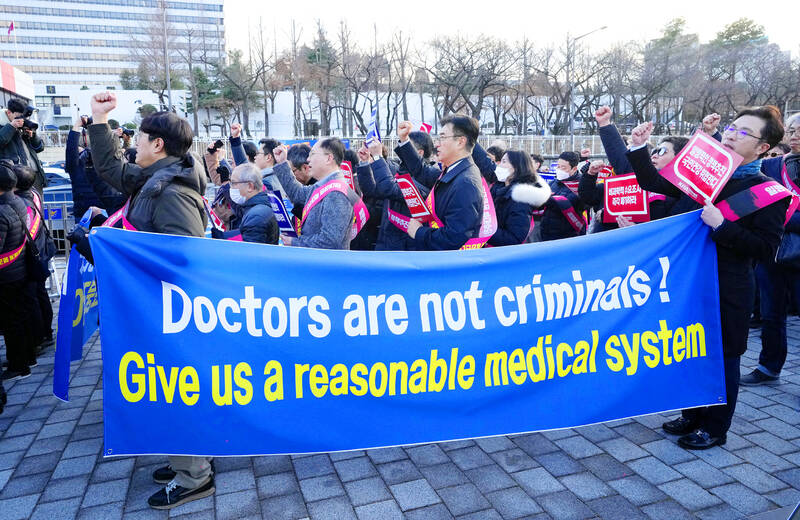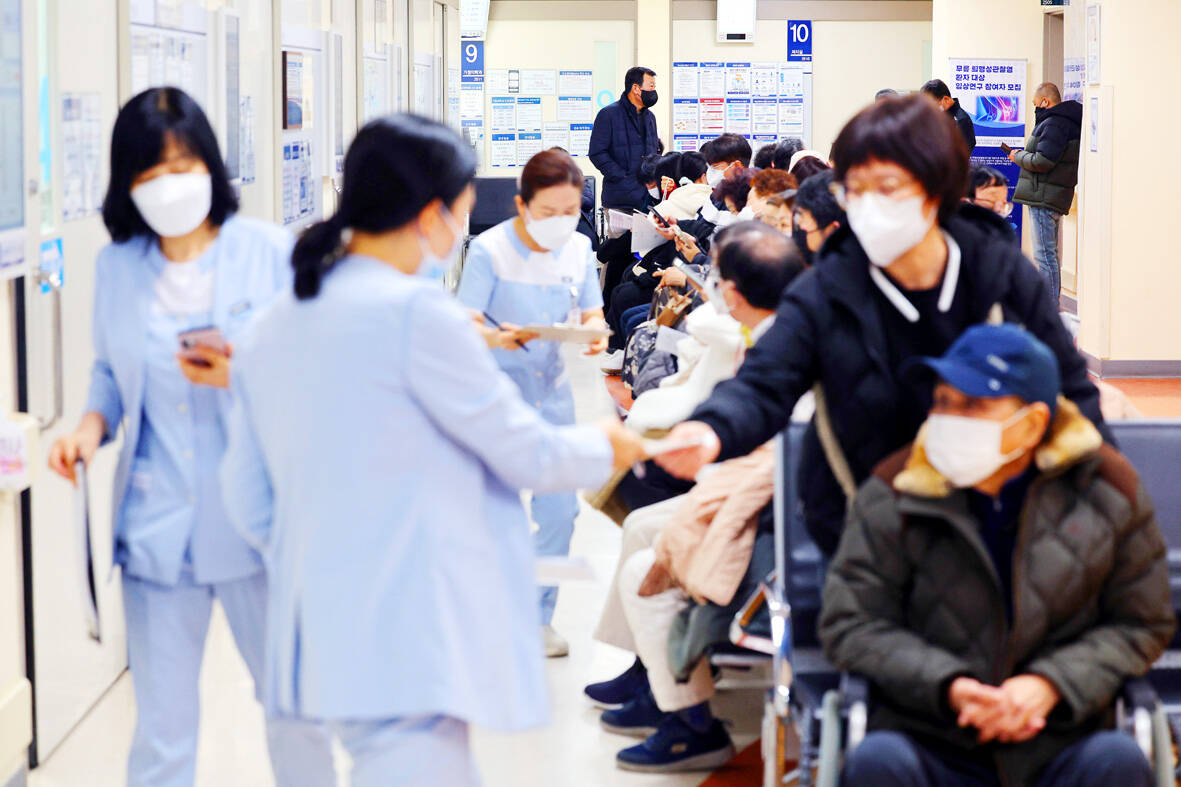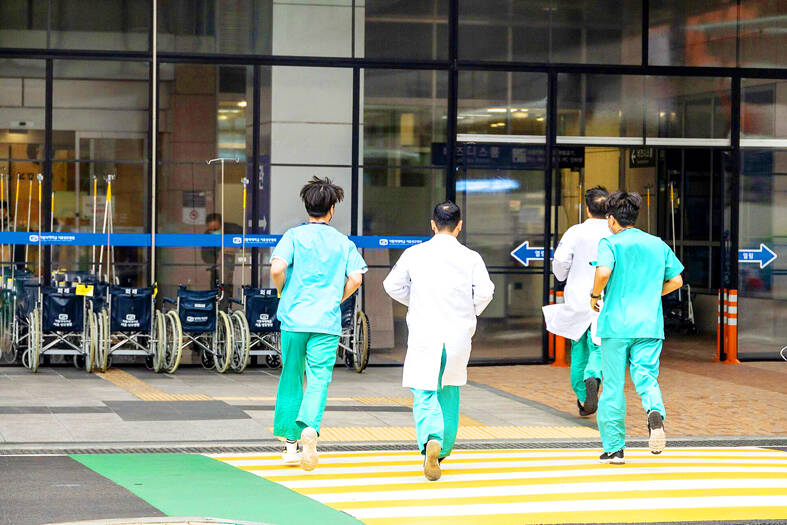Thousands of junior doctors in South Korea have been refusing to see patients and attend surgeries since they walked off the job Feb. 20 in response to the government’s push to recruit more medical students.
As of Tuesday last week, about 8,940 medical interns and residents have left their worksites in protest, disrupting the operations of major hospitals in South Korea and threatening to burden the country’s overall medical service.
WHY ARE DOCTORS STRIKING?

Photo: AP 照片:美聯社
The government plans to raise South Korea’s yearly medical school admission caps by 2,000, from the current 3,058.
The enrollment plan is meant to add up to 10,000 doctors by 2035 to cope with the country’s fast-aging population. Officials say South Korea has 2.1 physicians per 1,000 people — far below the average of 3.7 in the developed world.
The striking doctors-in-training say schools can’t handle an abruptly increased number of medical students. They predict that doctors in greater competition would perform overtreatment — increasing public medical expenses — and, like current medical students, most of the additionally recruited medical students would also likely try to work in high-paying, popular professions like plastic surgery and dermatology. That means the country’s long-running shortage of physicians in essential yet low-paying areas like pediatrics, obstetrics and emergency departments would remain unchanged.

Photo: EPA-EFE 照片:歐新社
Some critics say the striking junior doctors simply oppose the government plan because they worry that adding more doctors would result in a lower income.
Ahn Cheol-soo, a doctor-turned-lawmaker in the ruling party, said on a local TV program that he supports the government’s plan. But without fundamental steps to convince students to opt for the essential areas, Ahn said that “2,000 new dermatology hospitals will be established in Seoul 10 years later.”
WHAT DO THE STRIKES MEAN FOR PATIENTS?

Photo: Bloomberg 照片:彭博社
The walkouts have led hospitals to cancel numerous planned surgeries and other medical treatments. On Feb. 23, an octogenarian undergoing cardiac arrest was reportedly declared dead after seven hospitals turned her away, citing a lack of medical staff or other reasons likely related to the walkouts.
In some major hospitals, junior doctors account for about 30 percent to 40 percent of the total doctors, playing the role of supporting senior doctors during surgeries and dealing with inpatients. The strikers are among the country’s 13,000 medical residents and interns, and they work and train at about 100 hospitals in South Korea.
In the wake of the walkouts, the government has extended the working hours for public medical institutions, opened emergency rooms at military hospitals to the public and given nurses legal protection to conduct some medical procedures typically done by doctors.
Vice Health Minister Park Min-soo said Tuesday last week that the country’s handling of critical and emergency patients largely remains stable. But observers say the country’s overall medical service would suffer a major blow if the walkouts become prolonged, or if senior doctors join the strike.
The Korea Medical Association, which represents about 140,000 doctors in South Korea, has steadfastly expressed its support of the trainee doctors, though it hasn’t determined whether to join their walkouts.
Doctors are among the highest-paid professionals in South Korea, and the trainees’ walkout has so far failed to win public support, with a survey showing that about 80 percent of respondents support the government’s recruitment plan.
(AP)
南韓數千名基層醫師因反對政府推動招收更多醫學生而罷工,2月20日起一直拒絕看診與手術。
截至上週二,約8,940名實習醫師及住院醫師離開工作崗位,以示抗議,讓南韓大醫院的營運大亂,南韓整體醫療服務有被拖累的危險。
醫師為何罷工?
南韓醫學院每年的入學人數上限目前為3,058人,政府計劃再增加2,000人。
該招生計畫旨在2035年將醫師人數增加到1萬名,以因應南韓人口的快速老化。官員表示,南韓每1,000人擁有2.1位醫師,遠低於已開發國家3.7位的平均水準。
罷工的實習醫師表示,學校無法應付醫學生數量的突然增加。他們預測,由於醫師競爭更激烈,因此會進行過度治療,從而增加公共醫療費用;而且,像現在的醫學生一樣,大多數額外招收的醫學生也可能會想進入整形外科和皮膚科等高薪、受歡迎的領域。這意味南韓在兒科、產科和急診科等重要但低薪之科別長期缺乏醫師的情況將不會改變。
一些批評人士表示,罷工的基層醫師只是反對政府的計畫,因為他們擔心增加更多醫師會導致其收入下降。
醫師出身的執政黨議員安哲秀在當地電視節目中表示,他支持政府的計畫。但他說,若沒有根本性的措施來說服學生選擇重要的科別,「10年後首爾將會新成立2,000家皮膚科醫院」。
罷工對病患之影響
罷工導致醫院取消許多原訂之手術與其他醫療。據報導,2月23日,一名心臟驟停的八十多歲老婦遭七家醫院以缺乏醫務人員或與罷工相關之其他因素拒絕收治,而後被宣告死亡。
南韓有13,000名住院醫師及實習醫師,在全國約100家醫院工作與接受培訓。在一些大醫院,這些基層醫師約佔醫師總數的30%至40%,扮演協助資深醫師手術及照顧住院病人之角色。參與罷工的即是這些基層醫師。
罷工發生後,政府延長了公立醫療機構的診療時間,向民眾開放軍事醫院的急診室,並為護理師提供法律保護,讓他們可以執行一些通常由醫師完成的醫療程序。
南韓保健福祉部第二次官(副部長)朴敏守上週二表示,該國對重症與急診患者的處理大致仍屬穩定。但觀察家表示,若罷工時間延長,或資深醫師加入罷工,南韓的整體醫療服務將遭受重大打擊。
代表南韓約14萬名醫師的韓國醫學會堅定表達了對實習醫師的支持,但尚未決定是否加入他們的罷工。
醫師是南韓收入最高的專業人士之一,實習醫師罷工迄今未能贏得民眾支持,調查顯示,約80%的受訪者支持政府的醫學生招收計畫。
(台北時報林俐凱編譯)

A: What types of fruit enzymes should we take to help reduce eye floaters? B: According to a study published in the “Applied Sciences” journal by Taiwanese ophthalmologist Horng Chi-ting, pineapple, papaya and fig supplements can improve symptoms. A: Pineapples are in season now, so you should munch on more of those to get rid of floaters. B: Not quite. Enzymes can be damaged by our stomach acid if we eat the fruit directly. The doctor says taking fruit enzyme capsules is better for absorption. A: Most importantly, we should reduce our use of personal electronics to prevent floaters from

Rice is essential to Japanese culture, tradition and politics. People take pride in the oval-shaped sticky Japonica grain, which is still a staple even though total consumption has fallen over the decades. But since last summer, prices have soared as supplies have fallen short of demand. The government has long paid farmers to cut back on rice acreage, and change to other crops to keep rice prices relatively high. To cope with shortfalls this year, the government has released rice reserves. But the grain has been slow to reach supermarket shelves. Anger over that was part of the reason the Agriculture Minister

In Taiwan, 7-Eleven convenience stores can be found on almost every street corner. With over 84,600 stores across 20 countries, 7-Eleven has more locations than any other retail business on Earth. For millions of people, the chain is an important part of daily life, providing coffee, quick meals, and essential items for those __1__. The history of 7-Eleven began nearly 100 years ago in Dallas, Texas. In 1927, the Southland Ice Company began selling blocks of ice that were used to keep fridges cool. Shortly after opening, the company __2__ its offerings to include groceries like milk, eggs, and

Continued from yesterday(延續自昨日) https://www.taipeitimes.com/News/lang In 1946, the company adopted the name 7-Eleven to reflect its newly extended __3__, from 7am to 11pm, a novel concept at the time. As a rapidly growing company, it began offering franchise opportunities in the 1960s. In 1974, the first 7-Eleven in Japan was opened by the supermarket company Ito-Yokado. The Japanese franchises were __4__ successful that by 1991, Ito-Yokado was able to acquire a 70 percent stake in Southland Corporation. Its investments eventually resulted in full ownership of 7-Eleven, which paved the way for the Japanese company to enter the international market. Since then, 7-Eleven